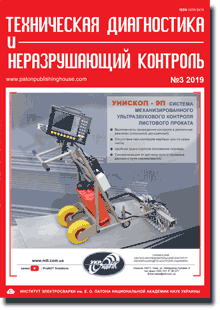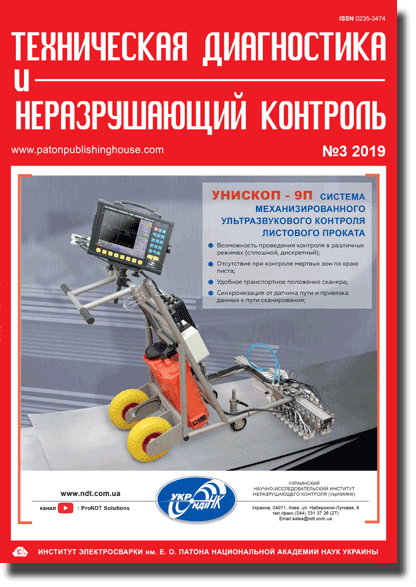| 2019 №03 (07) |
DOI of Article 10.15407/tdnk2019.03.08 |
2019 №03 (01) |

Technical Diagnostics and Non-Destructive Testing #3, 2019, pp. 55-60
Assessment of hardness and local damage of ceramics and glassby the method of scraping up to chipping out
V.V. Khvorostianyi , Y.M. Rodichev, O.B. Soroka
G.A. Pisarenko Institute for Problems of Strength of the NAS of Ukraine. 2 Timiryazevska str., 01014, Kyiv. E-mail: khvorostianyi.v.v@ipp.kiev.ua
Abstract:
The paper gives the results of experimental study of the regularities of damage in such brittle materials as glass and ceramics at local loading by the methods of sample surface scraping by Rockwell indenter up to chipping out. Hardness values at scraping of the studied brittle materials were determined. It is shown that hardness at scraping is higher than the hardness values at indentation with a standard sharp indenter, mostly by 20%. Dependencies of surface damage on load, as well as those between hardness at scraping, damage, modulus of elasticity and critical stress intensity factor, are presented. A method of application of experimental diagrams of brittle material damage for reliable determination of the degree of their local fracture, depending on the stress level is proposed. 23 Ref., 2 Tabl., 5 Fig.
Keywords: ceramics, glass, scraping up to chipping out, hardnessь, destruction distance, damage diagrams
Received: 27.06.2019
Published: 05.09.2019
References
1. Balkevich, V.L. (1984) Technical ceramics: Manual for Techn. Higher Inst. 2nd Ed. Moscow, Strojizdat [in Russian].2. Rodichev, Yu.M. (2005) Structural strength of brittle nonmetallic materials. Strength of materials and structures. Chapt. 9.2. Ed. by V.T. Troshchenko. Kiev, Akademperiodika, 955-992 [in Russian].
3. Khasanov, O.L., Bikbaeva, Z.G., Dvilis, E.S. et al. (2012) Hardness, microhardness and nanohardness of nanostructural ceramic materials. Tomsk, TPU [in Russian].
4. Scieszka S.F. (2005) Edge failure as a means of concurrently estimating the abrasion and edge fracture resistance of hard-metals. Tribology International, 38, 834-842. https://doi.org/10.1016/j.triboint.2005.02.011
5. Chai H. (2011) On the mechanics of edge chipping from spherical indentation. Int. J. Fract., 169, 85-95. https://doi.org/10.1007/s10704-011-9589-7
6. Khvorostyanyi, V.V. (2014) Mechanical behavior of ceramics and glasses at local fractures of edges of samples by Rockwell indenter. Problemy Prochnosti, 3, 106-115 [in Russian]. https://doi.org/10.1007/s11223-014-9560-8
7. Quinn G.D., Quinn J.B. (2014) A new analysis of the edge chipping resistance of brittle materials. Ceram. Eng. Sci. Proc., 35, 209-224. https://doi.org/10.1002/9781119031192.ch20
8. Khvorostyanyi, V.V., Panasenko, A.V. (2015) Evaluation of damage of edges of hard alloy tool under local loading. Sverkhtvyordye Materialy, 1, 75-82 [in Russian]. https://doi.org/10.3103/S1063457615010098
9. Gogotsi, G.A., Galenko, V.I., Mudrik, S.P. et al. (2007) Fracture of glass at edge chipping. Problemy Prochnosti, 6, 103 - 112 [in Russian].
10. (2010) CEN/TS 834-9. Advanced technical ceramics - Mechanical properties of monolithic ceramics at room temperature. Part 9: Method of test for edge-chip resistance. CEN (European Standard).
11. Williams J.A. (1996) Analytical models of scratch hardness. Tribology International, 29, 675-694. https://doi.org/10.1016/0301-679X(96)00014-X
12. Quinn J., Su L., Flanders L., Lloyd I. (2000) «Edge toughness» and material properties related to the machining of dental ceramics. Machining Science and Technology, 4, 291-304. https://doi.org/10.1080/10940340008945711
13. Zborshchik, A.M. (2008) Synopsis of lectures on the subject «New materials in metallurgy». Donetsk, GVUZ DonNTU [in Russian].
14. Lawn B.R., Marshall D.B. (1979) Hardness, toughness and brittleness: an indentation analysis. J. Am. Ceram. Soc., 62, 347-350. https://doi.org/10.1111/j.1151-2916.1979.tb19075.x
15. Anstis G.R., Chantikul P., Lawn B.R., Marshall D.B. (1981) A critical evaluation of indentation techniques for measuring fracture toughness: I. Direct crack measurements. Ibid, 64, 533-538. https://doi.org/10.1111/j.1151-2916.1981.tb10320.x
16. Cook R.F., Pharr G.M. (1990) Direct observation and analysis of indentation cracking in glasses and ceramics. Ibid, 73, 787-817. https://doi.org/10.1111/j.1151-2916.1990.tb05119.x
17. Hannink R.H.J., Kelly P.M., Muddle B.C. (2000) Transformation toughening in zirconia-containing ceramics. Ibid, 83, 461-487. https://doi.org/10.1111/j.1151-2916.2000.tb01221.x
18. Lee S.K., Tandon R., Readey M.J., Lawn B.R. (2000) Scratch damage in zirconia ceramics. Ibid, 83, 1428-1432. https://doi.org/10.1111/j.1151-2916.2000.tb01406.x
19. Deriano S., Jarry A., Rouxel T. et al. (2004) The indentation fracture toughness (K1c) and its parameters: the case of silica-rich glasses. J. Non-Cryst. Sol., 344, 44-50. https://doi.org/10.1016/j.jnoncrysol.2004.07.021
20. Gnesin, G.G., Osipova, I.I., Rontal, G.D. et al. (1991) Ceramic tool materials. Kiev, Tekhnika [in Russian].
21. (1979) Breaking strength: Manual for higher education inst. Ed. by G.S. Pisarenko. 4th Ed., Kiev, Vyshcha Shkola [in Russian].
22. Andrievsky, R.A., Lanin, A.G., Rymashevsky, G.A. (1974) Strength of refractory compounds. Moscow, Metallurgiya [in Russian].
23. Khvorostyanyi, V.V. (2016) Evaluation of hardness of ceramic materials at scratching of sample surface by Rockwell indenter. In: Proc. of of I.A.Oding Sci. Lectures, RAS, Mechanical Properties of Modern Structural Materials (Moscow, 6-7 September 2016), 136-137 [in Russian].
The cost of subscription/purchase order journals or individual articles
| Journal/Currency | Annual Set | 1 issue printed |
1 issue |
one article |
| TPWJ/USD | 384 $ | 32 $ | 26 $ | 13 $ |
| TPWJ/EUR | 348 € | 29 € | 24 € | 12 € |
| TPWJ/UAH | 7200 UAH | 600 UAH | 600 UAH | 280 UAH |
| AS/UAH | 1800 UAH | 300 UAH | 300 UAH | 150 UAH |
| AS/USD | 192 $ | 32 $ | 26 $ | 13 $ |
| AS/EUR | 180 € | 30 € | 25 € | 12 € |
| SEM/UAH | 1200 UAH | 300 UAH | 300 UAH | 150 UAH |
| SEM/USD | 128 $ | 32 $ | 26 $ | 13 $ |
| SEM/EUR | 120 € | 30 € | 25 € | 12 € |
| TDNK/UAH | 1200 UAH | 300 UAH | 300 UAH | 150 UAH |
| TDNK/USD | 128 $ | 32 $ | 26 $ | 13 $ |
| TDNK/EUR | 120 € | 30 € | 25 € | 15 € |
AS = «Automatic Welding» - 6 issues per year;
TPWJ = «PATON WELDING JOURNAL» - 12 issues per year;
SEM = «Electrometallurgy Today» - 4 issues per year;
TDNK = «Technical Diagnostics and Non-Destructive Testing» - 4 issues per year.





